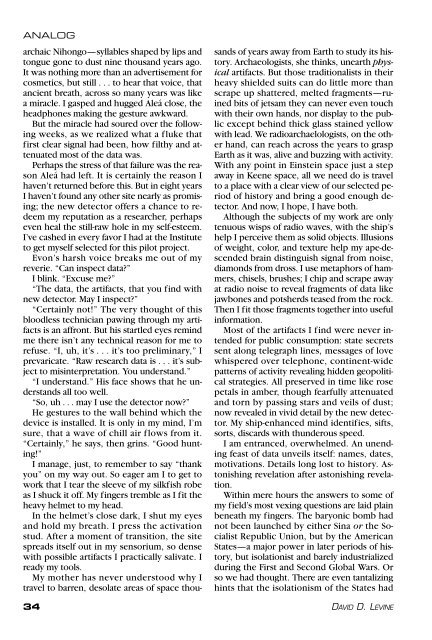Analog Science Fiction and Fact - June 2013
Analog Science Fiction and Fact - June 2013
Analog Science Fiction and Fact - June 2013
Create successful ePaper yourself
Turn your PDF publications into a flip-book with our unique Google optimized e-Paper software.
ANALOG<br />
archaic Nihongo—syllables shaped by lips <strong>and</strong><br />
tongue gone to dust nine thous<strong>and</strong> years ago.<br />
It was nothing more than an advertisement for<br />
cosmetics, but still . . . to hear that voice, that<br />
ancient breath, across so many years was like<br />
a miracle. I gasped <strong>and</strong> hugged Aleá close, the<br />
headphones making the gesture awkward.<br />
But the miracle had soured over the following<br />
weeks, as we realized what a fluke that<br />
first clear signal had been, how filthy <strong>and</strong> attenuated<br />
most of the data was.<br />
Perhaps the stress of that failure was the reason<br />
Aleá had left. It is certainly the reason I<br />
haven’t returned before this. But in eight years<br />
I haven’t found any other site nearly as promising;<br />
the new detector offers a chance to redeem<br />
my reputation as a researcher, perhaps<br />
even heal the still-raw hole in my self-esteem.<br />
I’ve cashed in every favor I had at the Institute<br />
to get myself selected for this pilot project.<br />
Evon’s harsh voice breaks me out of my<br />
reverie. “Can inspect data?”<br />
I blink. “Excuse me?”<br />
“The data, the artifacts, that you find with<br />
new detector. May I inspect?”<br />
“Certainly not!” The very thought of this<br />
bloodless technician pawing through my artifacts<br />
is an affront. But his startled eyes remind<br />
me there isn’t any technical reason for me to<br />
refuse. “I, uh, it’s . . . it’s too preliminary,” I<br />
prevaricate. “Raw research data is . . . it’s subject<br />
to misinterpretation. You underst<strong>and</strong>.”<br />
“I underst<strong>and</strong>.” His face shows that he underst<strong>and</strong>s<br />
all too well.<br />
“So, uh . . . may I use the detector now?”<br />
He gestures to the wall behind which the<br />
device is installed. It is only in my mind, I’m<br />
sure, that a wave of chill air flows from it.<br />
“Certainly,” he says, then grins. “Good hunting!”<br />
I manage, just, to remember to say “thank<br />
you” on my way out. So eager am I to get to<br />
work that I tear the sleeve of my silkfish robe<br />
as I shuck it off. My fingers tremble as I fit the<br />
heavy helmet to my head.<br />
In the helmet’s close dark, I shut my eyes<br />
<strong>and</strong> hold my breath. I press the activation<br />
stud. After a moment of transition, the site<br />
spreads itself out in my sensorium, so dense<br />
with possible artifacts I practically salivate. I<br />
ready my tools.<br />
My mother has never understood why I<br />
travel to barren, desolate areas of space thou-<br />
s<strong>and</strong>s of years away from Earth to study its history.<br />
Archaeologists, she thinks, unearth physical<br />
artifacts. But those traditionalists in their<br />
heavy shielded suits can do little more than<br />
scrape up shattered, melted fragments—ruined<br />
bits of jetsam they can never even touch<br />
with their own h<strong>and</strong>s, nor display to the public<br />
except behind thick glass stained yellow<br />
with lead. We radioarchaelologists, on the other<br />
h<strong>and</strong>, can reach across the years to grasp<br />
Earth as it was, alive <strong>and</strong> buzzing with activity.<br />
With any point in Einstein space just a step<br />
away in Keene space, all we need do is travel<br />
to a place with a clear view of our selected period<br />
of history <strong>and</strong> bring a good enough detector.<br />
And now, I hope, I have both.<br />
Although the subjects of my work are only<br />
tenuous wisps of radio waves, with the ship’s<br />
help I perceive them as solid objects. Illusions<br />
of weight, color, <strong>and</strong> texture help my ape-descended<br />
brain distinguish signal from noise,<br />
diamonds from dross. I use metaphors of hammers,<br />
chisels, brushes; I chip <strong>and</strong> scrape away<br />
at radio noise to reveal fragments of data like<br />
jawbones <strong>and</strong> potsherds teased from the rock.<br />
Then I fit those fragments together into useful<br />
information.<br />
Most of the artifacts I find were never intended<br />
for public consumption: state secrets<br />
sent along telegraph lines, messages of love<br />
whispered over telephone, continent-wide<br />
patterns of activity revealing hidden geopolitical<br />
strategies. All preserved in time like rose<br />
petals in amber, though fearfully attenuated<br />
<strong>and</strong> torn by passing stars <strong>and</strong> veils of dust;<br />
now revealed in vivid detail by the new detector.<br />
My ship-enhanced mind identifies, sifts,<br />
sorts, discards with thunderous speed.<br />
I am entranced, overwhelmed. An unending<br />
feast of data unveils itself: names, dates,<br />
motivations. Details long lost to history. Astonishing<br />
revelation after astonishing revelation.<br />
Within mere hours the answers to some of<br />
my field’s most vexing questions are laid plain<br />
beneath my fingers. The baryonic bomb had<br />
not been launched by either Sina or the Socialist<br />
Republic Union, but by the American<br />
States—a major power in later periods of history,<br />
but isolationist <strong>and</strong> barely industrialized<br />
during the First <strong>and</strong> Second Global Wars. Or<br />
so we had thought. There are even tantalizing<br />
hints that the isolationism of the States had<br />
34 DAVID D. LEVINE

















